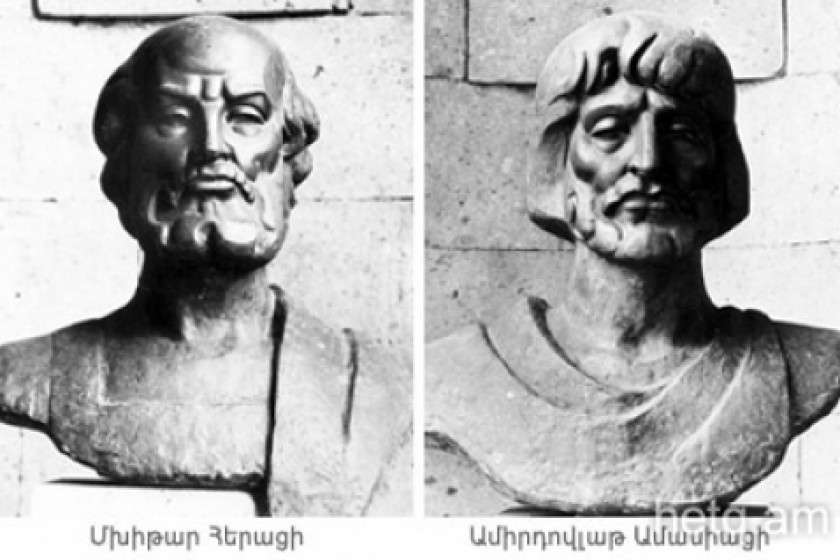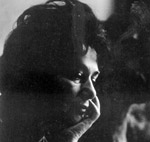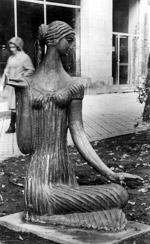
Yerevan: A City of Disappearing Sculptures
Bust of Mkhitar Heratsi the Latest Victim
On the night of July 26 the bronze bust of Mkhitar Heratsi, the father of Armenian medicine, disappeared from in front of the entrance to the Vladimir Avagyan Medical Center at 15 Moskovyan Street, Yerevan The bronze bust of Amirdovlat Amasiatsi, another medieval Armenian physician, was also displayed nearby. The thieves, it seems, didn’t have time to steal this one as well.
The author of the sculptures is 88 year-old Tereza Mirzoyan, a distinguished Armenian artist and painter
. 
Tereza is not aware of the stolen sculpture. Her relatives didn’t wish to upset her with the news. The first to find out about the theft was Mirzoyan’s son-in-law Hovakim, who just happened to notice bust was missing when he passed by the Center one day. The thieves managed to remain unnoticed despite the fact that the medical center has a watchman. According to Anoush Arakelyan, Tereza’s daughter, the medical center administration pointed out that the building has several entrances, and the sculpture was stolen when the watchman was patrolling elsewhere. “I want to be an optimist and believe that the watchman was really unaware of it,” says Anoush, though she can’t understand how the thieves could remain unnoticed in that central and busy part of the city, even if it was already dark. The staff of the medical center called the police on the 27th and a criminal case was initiated against the thieves. Nevertheless, the case was withdrawn later due to one simple reason – the absence of suspects. After the Heratsi sculpture was stolen, the medical center took some security measures and placed the Amirdovlat Amasiatsi bust inside the building. Anoush Arakelyan, however, says that the medical center’s staff didn’t have the slightest idea of the sculpture’s real value. The Artists Union of Armenia sent letters concerning the case to the RoA Chief of the Police, the Mayor of Yerevan, the head of the Kentron Administrative District of Yerevan, the Chief of the Kentron Police District and to the Minister of Culture. The letter reads, “The sculpture that was carved in 1984 represents an artistic and cultural value and is estimated at 5,400,000 AMD.” This appraisal was made during Soviet years by a special cultural committee. Gagik Ghazaryan, the Chairman of the Union of Artists, notes that in Soviet years no one thought that a work of art, placed in a public place, could be stolen. That is the reason why only a separate metal tin was welded under the hollow bronze sculpture, which was fastened to the base by a nail. The thieves managed to pull the sculpture from the metal tin, which remained fixed to the base. According to Ghazaryan, Mkhitar Heratsi’s bust weighed about 110-132 pounds and that it was a job requiring more than one person. At the same time the sculptor is quite certain that in such cases the thieves immediately cut up the ill-gotten booty and sell it off as scrap to precious metal buyers. Anoush Arakelyan also holds out little hope that her mother’s sculpture will turn up, especially since this is not the first time that a Mirzoyan sculpture has been stolen. 
Back in the late 1980s another Mirzoyan sculpture called “Loves me, doesn’t love me” was stolen right from Abovyan Street, one of the main thoroughfares of Yerevan. The sculpture, however, was never found. The family says it has contacted various agencies to get the word out to law-enforcement and the public at large to be on guard against this type of crime, which seems to be spreading. Most have yet to respond to the letters sent. Referring to the theft, Gagik Ghazaryan points out that during the last two or three years the number of stolen statues and busts has considerably increased in Yerevan and that the vandalism of monuments is also on the rise. He mentioned the theft of Levon Nersisyan’s and Hrachya Acharyan’s bronze masks on Mashtots Avenue, opposite the Nayiri Cinema, how Sergey Baghdasaryan’s mask was stolen from Kievyan Street, as well as the theft of about 40 bronze works, among them various portraits and sculptures, from the Khachatur Abovyan House-Museum. In the 1990s they stripped the Yerevan-Sevan highway of a huge copper sculpture depicting an Armenian woman at repose with a pitcher. After the sculpture Yura Movsisyan passed away, thieves ransacked his work studio and carted off 15 bronze works. Even cemeteries are considered fair game by thieves – everything containing precious metals is carted off. Two of Gagik Ghazaryan’s bronze sculptures have also been stolen from a local cemetery and one has been vandalized. There are numerous such examples and the list is growing. Yerevan has become a city of disappearing sculptures.
Translated by Ani-Nicole Babayan
 Videos
Videos Photos
Photos
Write a comment